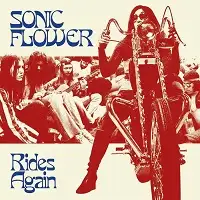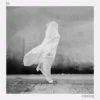Rides Again
Sonic Flower
•
February 7, 2021

On January 29 2020, a rock band entitled SONIC FLOWER released a recording from sessions occurring during year 2005. The band formed as an instrumental side project that emanated from the rock band entitled CHURCH OF MISERY. SONIC FLOWER styles bluesy instrumental songs reminiscent of 1970s stoner rock, combining the florals of the 1960s with the modern doom edge of heavier rock–even metal. A garden of ornamental flowers replete with rocks & stones–or rockers and stoners if you prefer. We collectively wonder what has become of the weeds amidst these floral mosaics of powerful sound.
"Super Witch" - the first album track and also the fastest on the release begins abruptly, and before thirty seconds pass, Yasuto Muraki ventures his first traditional blues style guitar solo, and by one minute twenty seconds - he's added his second solo. At about two minutes twenty five seconds, Keisuke Fukawa changes from a standard drum beat to a floor tom enhanced drive to enhance the aggression of the bluesy rock: heads of listeners may "bob" rather than "thrash"–yet pleasantly and more safely so; Tatsu Mikami plays a bass rhythm similar to the floor tom rhythm, while Yasuto Muraki rhythmically & musically scratches along the low 'e' power chord of the guitar.
"Black Sheep" - the second album track, begins with a finger slide up & down the neck along the distorted guitar strings (like a pick up note) as SONIC FLOWER enters an eight measure phrase in (4/4 // standard time) during which Yasuto Muraki's guitar begins a two measure phrase for the band to "pop" on the fourth beat, and for the second measure of this eight note sequence, the band "Pops" again on beats three and four (not just four–as on the first measure of this two measure sequence); this eight measure sequence last about twenty five seconds. Just after forty seconds pass, Tatsu Mikami's bass, perhaps not soloing, but, adds extensive ornamentation of florid, sonorous color. The band then plays the thematic song melody. Recapitulations of the head melody intermix with sporadic bouts of traditional bluesy style guitar solos.
"Jungle Cruise" - the third album track opens with seemingly pre-recorded voices (presumably the band in the studio) while congas, together with a melodic bass theme, lay a syncopated groove. Drums augment this rhythmic pattern reminiscent of the hard rock band SANTANA. The regular guitar, bass, and drum combination replaces the congas (and the drum embellished percussive groove) with a presentation of the song's melody at about forty seconds. At about fifty seconds into the tune, the programmatic, percussive rhythmic instrumentation resumes–as does the physical groove. Yasuto Muraki plays a traditional lead guitar solo on the higher stretches of the guitar over a return of the conga enhanced rhythms. Throughout the third minute, Tatsu Mikami's bass plays the melodic theme over which Yasuto Muraki solos.
"Captain Frost" - the fourth album track begins with an immediate presentation of the melodic themes–and initial guitar leads begin by just after thirty seconds. Musical themes are represented in melodic unison between the guitar and bass; while drums–through a suggestive provocation, add to the harder edge of the music. At one minute forty seconds, another guitar solo begins, though this solo is more in the middle guitar range rather than the higher stretches of the neck. At about two minutes fifteen seconds, Tatsu Mikami's bass adds ascending melodic phrase interventions. After four measures of this, Yasuto Muraki's guitar adds a distorted pedal note on the bottom, low 'e' string. The song recapitulates to the main theme before Yasuto Muraki ends the song with a traditional solo.
"Stay Away" - the fifth album track has a unique opening with a combination of Yasuto Muraki's guitar and Tatsu Mikami's bass for the presentation of a melodic theme–western listeners might feel a subtle, aural connotation of "eastern", while Keisuke Fukawa - adds a sixteen note pattern on slightly open hi-hats: this pattern endures for six beats before slowly opening the hi-hats for each of the final two rhythmically sequential beats. The song progresses to almost seem like a concerto, (a piece of music intended to feature, usually, one instrument) for Keisuke Fukawa's snare drum. Just prior to the passing of two minutes, the guitar and bass resume their formal tone - but re-present another melody–with keyboards to add a pedal tone in the soprano register. Further drums resume, amidst additional keyboards resembling an organ to highlight moments of bass and also moments of guitar. The final minute replays Keisuke Fukawa's snare drum patterns, while simultaneously representing Yasuto Muraki's guitar and Tatsu Mikami's respective bass patterns.
"Quicksand Planet" - the sixth album track opens with single bent notes along the higher guitar strings before the song presents major melodic themes that progress into the first guitar solo. After one minute the song breaks into a pattern of drum fills to then recapitulate back to the main melodic song theme. At about two minutes fifteen seconds, distorted bass sounds replace the former drum fills precluding another presentation of the main melodic themes–for another traditional lead style guitar solo as we progress into the third minute and beyond. Another guitar solo emerges through the middle range of the guitar that culminates with a sustained note in honor of Jimi Hendrix himself–about which listeners would rather hear than read.
"Earthquake" - the seventh & final album track opens as a cover tune of the original recording by GRAHAM CENTRAL STATION. After about twenty five seconds of Yasuto Muraki's collective, amplified feedback, as though the track begins with the song-end: certainly no 'song-end' (finality) can begin so well as with the resounding cracks of doom metal: what better way to represent an "Earthquake"? Keisuke Fukama's crash "cymbolistic" style abounds with periodic pounds, and at twenty five seconds he subtly rides with open hi-hat hits by a drumstick shoulder (for a sound little less than a gong hit with a rubber mallet–dampened only by a mere piece of felt!). Initial motives of the main theme begin at about twenty five seconds–and recur to further develop for a full presentation of the main theme at about forty two seconds; as one minutes passes, Yasuto Muraki utilizes a sixteenth-note & eighth-note pattern to present a rhythmically scratched guitar chords "Cha-chooka-Chaa / chooka-cha-ka-cha". The first traditional guitar solo initiates minor derivatives from the first motives previously presented between twenty five & forty two seconds into the song. The style is of a bluesy rock–inclusive of thematic, short string bent notions of motivic developments. Once we reach the third minute we hear subtle bits of wah in the elongated scratches of rhythm guitar for an additional shorter (traditional) guitar solo that culminates at about three minutes overcome by a resurgence of amplified feedback. The guitar pick glides along the heavier wound strings–and even heavier rockers (with smaller doses of metallic compounds ringing in their ears) know the drill. This reverts to an additional recapitulation that eventually closes the song & entire musical publication.
8 / 10
Excellent
Songwriting
Musicianship
Memorability
Production

"Rides Again" Track-listing:
1. Super Witch
2. Black Sheep
3. Jungle Cruise
4. Captain Frost
5. Stay Away (METERS Cover)
6. Quicksand Planet
7. Earthquake (GRAHAM CENTRAL STATION cover)
Sonic Flower Lineup:
Yasuto Muraki - Guitars
Tatsu Mikami - Bass
Keisuke Fukawa - Drums
More results...





















